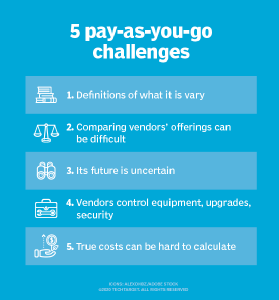What is subscription-based pricing model?
A subscription-based pricing model is a payment structure that allows a customer or organization to purchase or subscribe to a vendor's IT services for a specific period for an agreed-upon set price. Subscribers typically commit to the services on a monthly or annual basis.
Subscription-based pricing is commonly used for cloud computing. In a subscription-based model, cloud customers pay upfront, before receiving access to cloud services. Prices are often based on the subscription's length. A longer subscription frequently translates to a lower cost.
Cloud customers that use significant resources can benefit from a subscription-based model. However, if a customer only uses a small amount of computing resources, a subscription-based pricing model may not be ideal. Some cloud providers offer a subscription-based model that can adjust to reflect actual usage. Subscription pricing terms are documented in the provider's service-level agreement (SLA).
Types of subscription-based pricing models
The types of five subscription-based pricing models include:
Flat-rate pricing. Also known as fixed pricing, this model offers a predictable billing process as customers pay for a single product with a fixed set of features for a flat rate. It is the simplest of all the models for the business and customer, but it is not always the most cost-effective.
Tiered pricing. Tiered pricing refers to multiple packages that have different price points. Typically, in the form of basic, standard and premium, this model offers combinations of added features and products for additional pricing. If an organization's needs change, it can upgrade or choose a lower tier.
Per-user pricing. The pricing for this model is based on the number of people using the product; it scales with the business. The more users, the more it costs. A variant of this model is the per-unit model, which refers to a base product with the option to add units. For each added unit, customers could pay a higher price for an upgraded level of functionality. For instance, collaboration tools such as Microsoft 365 or Slack charge businesses based on the number of active users.
Usage-based. Also referred to as the pay-as-you-go model, cloud providers such as AWS and Microsoft Azure commonly employ usage-based pricing. This pricing offers low upfront costs and flexibility. Customers are only charged for what they use.
Advantages and disadvantages of subscription-based pricing
Here are some advantages and disadvantages of subscription-based pricing.
Advantages
- Predictable revenue streams: Subscription models provide consistent income for providers.
- Customer loyalty: Regular interactions foster long-term relationships with customers.
- Cost management for customers: Customers can budget effectively with predictable costs.
- Upselling opportunities: Providers can encourage customers to upgrade to higher-tier plans.

Disadvantages
- Churn risk: Providers face potential revenue loss if customers cancel subscriptions.
- Complexity for niche needs: Customers with specific requirements may find tiered or flat-rate pricing less effective.
- Delayed ROI: It often takes time for providers to recover the costs of acquiring new subscribers.
Emerging trends in subscription-based pricing models
In addition to its advantages and disadvantages, the subscription-based model continues to evolve, introducing features to enhance flexibility and customer satisfaction:
- Hybrid pricing models: Vendors increasingly offer a combination of subscription and usage-based pricing, enabling customers to pay for baseline services with adjustments for actual usage.
- AI-driven pricing: Cloud vendors use AI tools to personalize subscription packages based on customer behavior and preferences.
- Bundled services: Providers now offer bundled plans with value-added features such as enhanced customer support, training and analytics to differentiate their offerings.
- Freemium-to-premium conversion: Businesses use free plans to attract users, encouraging them to upgrade to paid tiers for additional functionality.
How to choose between subscription models
Choosing the right subscription model involves balancing organizational needs, customer preferences and budget constraints. For example, flat-rate pricing might suit small businesses seeking simplicity, while enterprise clients with varying needs might benefit more from tiered or hybrid models.
Organizations should also consider the total cost of ownership (TCO), including maintenance, upgrades and customer support. Ultimately, the decision should align with the business's growth strategy and ensure scalability.
Cloud computing is the ideal platform for building and deploying modern applications. Discover its key characteristics, including scalability, flexibility, multi-tenant architecture and on-demand resource access.







